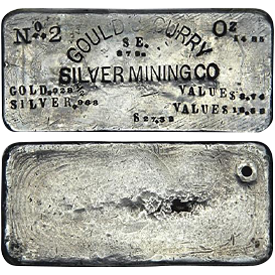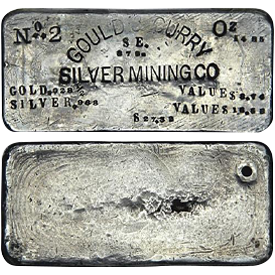The Gould & Curry Silver Mining Company’s heydays were the years 1863-64, just before statehood. Incorporated a few years earlier, the founder of the original claim in the Comstock was Albert Gould, who unwisely sold his share of half the mine for a pittance and died years later and nearly broke in Reno. The mine was, in its peak earning years, the biggest producer of silver ore in the country and one of its namesakes, Abraham Curry, became the first superintendent of the Carson City Mint, which was opened principally to accommodate the huge amounts of silver bullion coming from the Comstock.
There are several what might be called “species” of silver assay ingots bearing the Gould & Curry ethnic. Three of them were found in Mr. Ford’s collection. The last is typified by the bar illustrated in Dave Bowers’ American Coin Treasures and Hoards (p.275) and in Bowers & Ruddy’s Henry Clifford Sale catalogue (lot 229). Since the Gould & Curry Silver Mining Company was a huge operation for its day and the bars it routinely poured were large and heavy ones, it must therefore be assumed that smaller silver bars bearing the company’s ethnic were made as souvenirs and keepsakes.
In July, 1965 John 0. Curtis, then curator of architecture at Old Sturbridge Village in Massachusetts, wrote to Dr. George Miles, curator at the American Numismatic Society, inquiring about a silver assay bar, asking if Dr. Miles could tell him anything about it. Mr. Ford learned about the bar through Hillel Kaslov at the A.N.S. and wrote Curtis late that month asking if the bar could be shipped to him for photography and offering to buy it. Curtis replied early in August that the bar was actually owned by William Warren, the chief curator at Old Sturbridge Village, and stated that he thought Warren actually owned two such ingots. At the same time, Warren wrote Ford saying the bars he owned had come from his father and that they were not for sale. By late September Warren had decided to send one of the ingots to Ford for photography and it arrived on September 21, 1965. Warren’s ingot was the Gould & Curry bar number 8280. Ford returned it to Warren on November 19 the same year (Ford subsequently bought the bar on April 11, 1966). In the course of their correspondence, Warren told Ford that Warren’s nephew, Richard Warren, Jr., owned the other bar Curtis had mentioned, another Gould & Curry ingot, this one bar number 2. On expressing his interest in photographing that ingot, as well, William Warren sent the second bar to Ford on January 17, 1966. Ford returned it 10 days later and bought it on March 23, 1966.
In a letter dated 12/28/1965 addressed to John Ford at New Netherlands Coin Company on the stationery of Old Sturbridge Village, Sturbridge, Massachusetts and signed William L. Warren, Chief Curator, Warren states:
Here is a Xerox of the other ingot. I went into Boston before Christmas and my nephew found the ingot and we both forgot about it. He went to New Haven for Christmas and when he brought his family up to my home in Litchfield last Sunday, brought his ingot.
So, if after looking at the ingot, you think it important enough to photograph, I shall send it to you.
No one else in the family remembers these ingots or how my father acquired them. I feel pretty sure that his cousin Edwin Tomlinson from Quaker Farms, Connecticut gave them to father. Mr. Tomlinson left Connecticut right after the Civil War and traveled all during his adult life. He went all over the West investing in mining companies and actually mining himself in the northwest and Canada. He spent some time in California and Alaska, panning for gold and I have samples of gold nuggets and sand.
The two largest Alaskan gold nuggets are at the Peabody Museum, New Haven.
A subsequent letter dated 2/18/1966 addressed to John Ford at Rockville Center, N.Y. on the stationery of The Stowe-Day Foundation. Hartford, Connecticut and signed by William Warren states:
Your letter of Jan. 28th. I have sent on to my nephew asking whether he wants to sell his ingot.
Recently, I ran across a memo my father wrote in 1949 in which he lists the family silver. The ingots were on the list and he made no mention of where they came from or how they came into his possession. So I may have assumed incorrectly about Edwin Tomlinson giving them to my father. Neither of my brothers knew anything about them, though they remembered the ingots.
Museums have so much material that all of it can’t be displayed. They need more storage room than display space. If it is a big collection you have, it is better to have only parts of it showing at any one time. Exhibits get static and it is better to change things and move them around. By doing so, the curators remember the artifacts and freshen their minds and the exhibits.
A final letter accompanying this lot, dated 3/23/1966 addressed to William Warren at The Stowe-Day Foundation on Mr. Ford’s personal Rockville Center letterhead stationery, states:
Many thanks for your letter which arrived while I was traveling throughout the West on a combination business and pleasure trip. Actually, I broke my left hand early last month, and soon found my left arm (up to the
elbow) in plaster. Accordingly, I could not type (my bread and butter), and decided to ‘go on the road.’ Among other places, I visited the Arizona Pioneers Historical Society in Tucson. There, I found employed the ‘rotating display’ concept you so aptly described in your letter.As you can see by the enclosed copy of my letter to your nephew, I have sent him my check for $300 in payment for his Gould & Curry ingot. Just as soon as he lets you know that he has the check alright, I would appreciate your sending the piece down to me.
The offer in my letter of January 28th is still valid.
If you want to send me your Gould & Curry ingot, 1 will send you my check in the amount of $450.
I will leave your earlier data re Edwin Tomlinson (and the ingots) in my files, but will note your new information as given in your last letter.
The two Warren family Gould & Curry ingots are very dissimilar in appearance, yet two of their three physical measurements are quite similar. Bar number 2 seems crude compared to bar number 8280 and some of the markings on it defy easy explanation. If it were only the second silver bar made by the company, its crudity may be explained by the inexperience of its makers. Bar number 8280, by contrast, is a finished product of an experienced and capable assay office.
The third Gould & Curry ingot that was featured in the Ford Collection was obtained from a New Hampshire dealer in 1977, who claimed he got it from a family resident in California in the 1930s. It is entirely unlike the two Warren bars in size, shape, and finish, but it does share the same ethnic logotype as found on ingot number 2.







